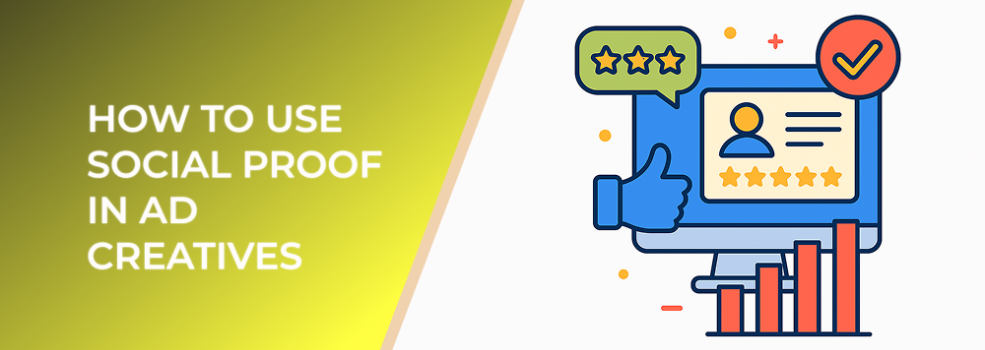Consumers trust people more than they trust brands. That is the simple truth behind social proof – and one of the biggest levers you can pull to make your ad creatives perform better.
When you build creatives around real customers, real numbers, and real results, you lower the perceived risk of clicking, signing up, or buying. In saturated feeds where every brand shouts for attention, ads that showcase social proof feel safer, more relevant, and more believable.
Why Social Proof Is a Performance Lever, Not Just a "Nice to Have"
Social proof is any signal that shows other people have already chosen, liked, or trusted your product. It is powerful because it reduces uncertainty. Instead of taking your word for it, the audience sees evidence from other people who look like them.
A few reasons to take it seriously in your ad creatives:
-
Almost all shoppers now read reviews before buying, and reviews directly influence the majority of purchase decisions.
-
A large share of consumers say authentic user-generated content (UGC) makes them more likely to trust a brand compared to polished brand content.
-
Ads that integrate UGC and real customer content often show significantly higher click-through rates and better conversion metrics than traditional studio-style creatives.

Shoppers who engage with ratings/reviews convert at ~2× the baseline
If your ads do not showcase what real customers say and do, you are leaving cheap conversion wins on the table.
Core Types of Social Proof You Can Use in Creatives
You do not need to use every type at once. Instead, build a library of assets and match them to the funnel stage and audience.
1. Ratings and Review Snippets
Star ratings and short review quotes are some of the easiest social proof elements to turn into creatives.
How to use them:
-
Highlight the average rating prominently (for example, "4.8/5 based on 2,134 reviews").
-
Pull 1–2 short, benefit-focused quotes that talk about outcomes, not just feelings ("cut our reporting time in half" beats "love this tool").
-
Add light visual structure: quotation marks, a subtle review card, or a verified-buyer badge to make it clear this is a real customer.
Where it works best:
-
Retargeting visitors who have already seen your product page
-
Performance-focused campaigns where the goal is to drive trials, demos, or purchases
2. User-Generated Photos and Videos (UGC)
UGC feels real and unscripted. People recognize that it comes from customers, not from your creative team.
How to use it:
-
Turn customer unboxing or tutorial clips into short vertical videos for feed and Stories.
-
Create carousels of real-life product photos, before-and-after shots, or screen recordings.
-
Add minimal overlays to keep the focus on the customer: a product name, a short hook, a clear call to action.
Why it works:
-
The content looks like the rest of the feed rather than an obvious ad.
-
It demonstrates outcomes in context: how the product fits into a routine, workflow, or lifestyle.
3. Numbers, Milestones, and Usage Data
Numbers are fast to process and highly persuasive.
Examples:
-
"Trusted by 12,000+ marketers"
-
"Used in 65 countries"
-
"Average 27% increase in conversion rate after 30 days"
-
"4.7 average rating from 3,500+ reviews"
Tips:
-
Pair a headline number with a simple visual (e.g., a big bold percentage and a subtle bar or gauge).
-
Make sure you can back every number up if someone asks.
4. Expert, Influencer, and Partner Endorsements
Third-party validation from experts or well-known brands can be a strong confidence boost.
How to use it:
-
Short quote from a recognizable expert or industry practitioner
-
Simple “as used by” or "chosen by" line next to partner logos
Keep it specific: endorsements that describe a concrete benefit or result are more credible than generic praise.
5. Trust Badges, Certifications, and Awards
Some products need extra reassurance around safety, compliance, or reliability.
Ideas:
-
Security badges (e.g., encryption, compliance) for tools handling sensitive data
-
Industry awards or rankings
-
Money-back guarantee or free trial badges
Use these badges as supporting elements rather than the entire creative concept. They are best combined with a review, UGC, or a strong benefit headline.
Mapping Social Proof to the Funnel
Different audiences need different signals. Match social proof to where people are in their decision process.
Top of Funnel (Cold Audiences)
Goal: build trust quickly and spark curiosity.
Best formats:
-
UGC-style videos showing the product in real life
-
Big credibility numbers (customers, reviews, results)
-
Well-known brand or media logos when you have the rights to use them
Avoid overly detailed reviews at this stage. Keep messages simple and emotional.
Middle of Funnel (Engaged but Not Yet Converting)
Goal: remove friction and answer doubts.
Best formats:
-
Review carousels grouped by use case (e.g., "saved time", "increased revenue")
-
Creatives that combine a strong benefit headline with a short testimonial
-
Side-by-side before/after visuals supported by customer quotes
Bottom of Funnel (High Intent / Cart Abandoners)
Goal: give the final nudge and reduce perceived risk.

Even reaching 10 reviews correlates with a 45% conversion lift
Best formats:
-
Creatives highlighting specific quantified results
-
Guarantees, risk-reversal badges, and social proof near the call to action
-
Ads that address top objections directly, with a review that contradicts those objections
Post-Purchase and Retention
Goal: deepen loyalty and trigger repeat actions.
Best formats:
-
Ads that thank customers and showcase community milestones
-
UGC roundups featuring real customers and their stories
Designing High-Performing Social Proof Creatives
1. Make One Proof Element the Hero
Do not overload a single creative with star ratings, five quotes, logos, and badges. Choose one primary element and let it breathe.
For example:
-
One standout review as the headline
-
One powerful statistic in large type
-
One before/after visual with a short caption
2. Keep Text Short and Legible
Most impressions will happen on mobile.
-
Aim for 6–10 words in the main text on the image.
-
Use larger font sizes and high-contrast color combinations.
-
Move longer explanations into the primary text field rather than the image.
3. Show Outcome, Not Just Satisfaction
A review saying "Amazing service" is weak. Strong social proof talks about specific outcomes, like:
-
"Cut our cost per lead by 32%"
-
"Doubled sign-ups in 3 months"
Whenever possible, pick reviews that connect directly to the metric you optimize for.
4. Preserve Authenticity
Polishing social proof too much can backfire.
-
Do not rewrite reviews until they no longer sound like customers.
-
Keep small imperfections (ellipses, casual phrasing) where they do not affect clarity.
-
If you anonymize names, keep some identity (initials, role, or industry) so the quote still feels real.
5. Stay Honest and Compliant
-
Never fabricate reviews or use testimonials without consent.
-
Avoid using third-party logos or influencer images without permission.
-
Make sure any performance claims are accurate and not misleading.
A Simple Testing Framework for Social Proof Creatives
Treat social proof like any other performance lever: test it.
Step 1: Choose the Right KPI
Decide what success looks like before you launch:
-
For upper-funnel ads: click-through rate (CTR), scroll-stop rate, or cost per click (CPC)
-
For mid/bottom-funnel ads: conversion rate (CVR), cost per acquisition (CPA), or return on ad spend (ROAS)
Step 2: Test One Variable at a Time
Keep your tests clean so you know what drove the uplift. A few ideas:
-
Review vs. no review in the same layout
-
UGC photo vs. studio product shot
-
Big number (e.g., customers) vs. performance metric (e.g., average ROI)
-
Short quote vs. longer story-style testimonial
Step 3: Build a Small Testing Matrix
Start with 3–6 creative variations that mix:
-
Format (static image, carousel, video)
-
Type of social proof (review, UGC, numbers, logos)
-
Angle (outcome-focused, objection-handling, credibility-focused)
Pause low performers quickly and reinvest into winners by creating new variations around the same angle.
Three Ready-to-Use Creative Concepts
Use these as starting points for your next batch of ads.
Concept 1: The "One Review That Sells" Creative
-
Visual: A clean card with a five-star rating at the top and one strong, outcome-focused quote in the center.
-
Text overlay: The key benefit pulled from the quote.
-
Primary text: A short intro plus a call to action (e.g., "See why thousands of customers switched in the last 90 days").
Best for: Mid- and bottom-funnel audiences who already know what you offer but need proof that it works.
Concept 2: UGC Story Carousel
-
Visual: 3–5 slides, each featuring a different customer photo or screenshot plus a short caption.
-
Flow: Problem → experience with the product → outcome.
-
Include a consistent call to action on each slide.
Best for: Cold and warm audiences on social platforms where people are used to tapping through carousels and Stories.
Concept 3: Proof-First Performance Banner
-
Visual: Large percentage or metric as the main element (e.g., "+27% more conversions").
-
Supporting text: One line explaining what changed, supported by a small testimonial quote.
-
Call to action: Focus on the next step ("Start your free trial", "Book a demo", "See case study").
Best for: Retargeting visitors, cart abandoners, and high-intent audiences.
Common Mistakes to Avoid
Even strong social proof can underperform if it is used poorly. Watch out for:
-
Overcrowded creatives: Too many elements competing for attention.
-
Vague quotes: Generic praise without specifics.
-
Outdated or low-quality UGC: Old screenshots, blurry photos, or reviews from years ago.
-
Irrelevant proof: Endorsements from audiences or industries that do not match your targeting.
-
Inconsistent claims: Different numbers in ads and on landing pages.
Social Proof Creative Checklist
Before you launch, run through this quick checklist:
-
Is there at least one clear social proof element in every core creative set?
-
Does each creative have a single, focused message?
-
Is the social proof easy to read on a small screen?
-
Are all numbers and testimonials accurate and verifiable?
-
Do the landing page and ad creative tell the same story?
-
Are you actively testing different types of social proof instead of relying on a single quote or metric?
If you can answer "yes" to most of these questions, your ads are in a strong position to convert skeptical scrollers into confident buyers.
Recommended Reading
To go deeper into psychology, creative fatigue, and ad testing, explore these related articles:

